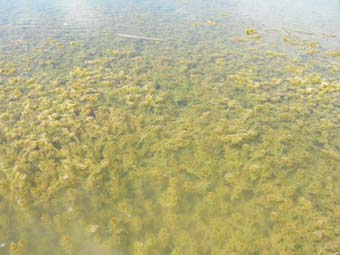
Forty scientists from eighteen countries take part in the 21st European Congress of Charophytologists (GEC-21), which is organised by the Cavanilles Institute of Biodiversity and Evolutionary Biology of the Universitat de València. It will take place on 18th and 19th September. The meeting analyses basic and applied aspects of charophytes -a group of seaweeds that is crucial in the maintenance of the aquatic ecosystems- both living and fossil. The experts will also work in Dehesa del Saler and the rice fields of Palmar and Sueca in the Natural Park of La Albufera.
The director of the organizing committee, Maria A. Rodrigo, professor of Ecology in the Universitat de València, highlights that this group of macrophytes develops an essential work to maintain the state of the clear waters of the aquatic masses. She affirms that the study of ecology and other aspects of macrophytes is essential in the preservation and conservation works since the regression and loss of these seaweeds entails the disappearance of the ecosystems services such as the environmental benefits for humans.
This congress aims at analysing the last advances in very different aspects of charophytes to stablish new challenges in its study for the following years. It is a question of interrelating the classical taxonomy with the modern (molecular) one or experimentally measuring the consequences of global change on this key group of organisms, fundamental aspects both for Valencian ecosystems, as well as for Spanish and European ecosystems.
The scientific program of the symposium includes several disciplines and research fields related to charophytes. There will be mainly oral presentations, divided into seven sessions to promote scientific discussion and debate. Some of the topics that will be discussed are taxonomy, biodiversity, biology and life cycles, distribution, interactions with epiphytes, conservation management or the impact of global change and human activities on these macroalgae.
Moreover, there is a workshop on the management techniques of charophytes that entails collaboration projects. The congress will also serve to discuss the edition of a volume on European charophytes (Aquatic Bioindication by Charophytes).
The congress will end with two visits to the natural environment in which they will observe and collect charophytes from the natural environments in which they live. The first visit, on 20th September, will be to the Albufera Natural Park. In particular, they will visit Dehesa del Saler and the rice fields of Palmar and Sueca. The researchers will then be able to observe in detail the Mediterranean species in the identification session that will take place in the Laboratory of Integrative Ecology of the Cavanilles Institute of Biodiversity and Evolutionary Biology. Finally, researchers will be transferred to the Lagunas de Ruidera Natural Park (Albacete-Ciudad Real) on 21st and 22nd September to observe other types of environments very different from the shallow aquatic masses in coastal areas.
International Association of Charophytologists
The International Research Group on Charophytes gathers experts from all over the world that study charophytes but from very different points of view. They study the classical and molecular taxonomy; the ecology, distribution and management of living charophytes such as the past taxonomy and distribution of fossil charophytes. ‘Knowing what happened in the past is crucial to predict what will happen in the future and to understand past we need present knowledges’, has highlighted Maria A. Rodrigo.
The congresses of the International Association of Charophytologists (AIC) take place every four years but in a different continent each time. There are research groups in the different continents that form regional groups. The European Group of Charophytes (GEC) is one of them and it gathers every year or two years. The symposium of València will be the second one in Spain since there was one in Barcelona eleven years ago. The last GEC meeting was in Geneva (Switzerland), where the Integrative Ecology Group (e3) of the Universitat de València was proposed to celebrate the 21st GEC Congress and to be recognised due to the researcher career that is developed in the Valencian institute. Scientists from Russia, Kazakhstan, Algeria, Israel and Lebanon, among other countries, will take part in the congress.
The sponsors of the 21st European Congress of Charophytologists have been the Cavanilles Institute of Biodiversity and Evolutionary Biology, the International Association of Charophytes (AIC) and the Iberian Association of Limnology (AIL).
More information about the congress in http://ir.uv.es/FXz2imh
Last update: 15 de september de 2017 13:10.
News release



















